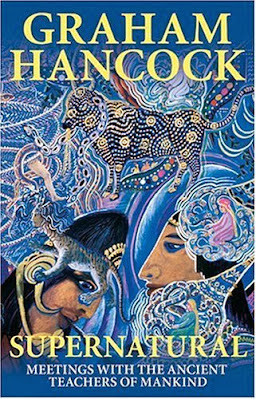 |
| Where dreams come to life... |
I've been reading Graham Hancock's book Supernatural and he comperes the similarity between alien experiences, accounts of fairies, DMT/ayahuasca journeys and other states of consciousness in a way I find quite thought provoking.
Reading this book is like bringing a number of supposedly unrelated subjects together into a finely woven tapestry.
I highly recommend reading this book with an open mind and then making your own judgments afterwards.
To be honest, if you had have asked me to consider the experience of the fairy world having a basis in reality a few months ago I would have thought you were pushing your luck with me on that one, but Graham has at least sat me on the fence with his arguments on this phenomena having some basis in our own reality.
Sounds nuts, I know, but read the book first and it may make a little more sense to you.
When Scott brought up the subject of fairies in his book on shamanism I have to say that he almost made me regret buying the book.
But reading Graham's book put fairy stories into a bit of a different light for me, not that I'm totally fine with it yet, but at least I'm willing to take a more fresh approach to a subject I thought I could never take seriously at all.
When I bought Julie McKenzie's book Dancing with Spirit through her website, I was offered her children's book about fairies for an extra $5, and at the last minute thought why not?
I have to say that after reading Graham's research on fairies, aliens and altered states of consciousness, some of the illustrations in this book become very interesting indeed.
Note also the hallucinogenic mushrooms that are never far away in the fairy illustrations.
Reading this book is like bringing a number of supposedly unrelated subjects together into a finely woven tapestry.
I highly recommend reading this book with an open mind and then making your own judgments afterwards.
To be honest, if you had have asked me to consider the experience of the fairy world having a basis in reality a few months ago I would have thought you were pushing your luck with me on that one, but Graham has at least sat me on the fence with his arguments on this phenomena having some basis in our own reality.
Sounds nuts, I know, but read the book first and it may make a little more sense to you.
When Scott brought up the subject of fairies in his book on shamanism I have to say that he almost made me regret buying the book.
But reading Graham's book put fairy stories into a bit of a different light for me, not that I'm totally fine with it yet, but at least I'm willing to take a more fresh approach to a subject I thought I could never take seriously at all.
When I bought Julie McKenzie's book Dancing with Spirit through her website, I was offered her children's book about fairies for an extra $5, and at the last minute thought why not?
Note also the hallucinogenic mushrooms that are never far away in the fairy illustrations.
Graham also says in a DMT experience Ferris wheels and carousels are often reported (see top picture).
Chinese style dragons are also something else reported in
DMT experiences.
Now, the thing with DMT is that you have it occurring naturally in the body, so you don't necessarily have to take it as a drug to trip out.
There are other ways to go into trance without taking drugs and some people (something like 2%) have a naturally high DMT level in their brain and could get into an altered state quite easily
(psychics maybe?).
Something to think about, I think when looking into these subjects.
 |
| http://www.starrfineart.com/paintings.html |















Living in Cornwall it's almost compulsory to believe in piskies - so why not Cornish fairies as well.
ReplyDelete@Mike
ReplyDeleteHancock specifically mentions the Pixies of Cornwall and the "fairy circles" that these fairy/pixies would get caught dancing in,which being from Australia reminds me very much of the Aborigine's sacred Bora rings that they dance around as well. "The word Bora was originally from south-east Australia, but is also now used throughout Eastern Australia to describe an initiation site or ceremony".
"Bora rings, are mandala-like formations found in south-east Australia. They comprise circles of foot-hardened earth surrounded by raised embankments. They were generally constructed in pairs (although some sites have three), with a bigger circle about 22 metres in diameter and a smaller one of about 14 metres. The rings are joined by a sacred walkway. While most are confined to south-east Queensland and eastern New South Wales, five earth rings have been recorded near the Victorian town of Sunbury, although Aboriginal use has not been documented."
http://en.wikipedia.org/wiki/Bora_%28Australian%29
psychedelic stuff here! I can see I'll have to get this book! I don't think I've ever seen this Mack video, thanks for posting!
ReplyDeleteThanks for that Darren and the link, interesting. In Cornwall they are known as Piskies, a much better class of Pixie! http://www.mysteriousbritain.co.uk/england/cornwall/folklore/the-piskies-of-cornwall.html
ReplyDelete